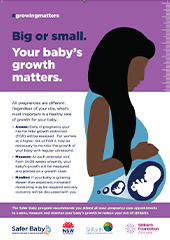Fetal Growth Restriction
All pregnancies are different. Regardless of a woman's Body Mass Index (BMI), what's most important is a healthy rate of growth for the baby. Fetal Growth Restriction (FGR) is when the baby is growing slower than expected and can indicate that the baby is not reaching its growth potential.
All women should be assessed for their risk of FGR in early pregnancy. This will include a combination of assessment and measurement, and for some women it may be necessary to monitor the growth of the baby by ultrasound.
- Assessment: Early in pregnancy, a woman's individual risk factors for FGR will be assessed. For women at a higher risk of FGR it may be necessary to monitor the growth of your baby with regular ultrasound.
- Measurement: At each antenatal visit from 24-28 weeks onwards, the baby's growth will be measured, this is called the symphysial fundal height (SFH). This measurement is then plotted on a growth chart and will be noted in the pregnancy record.
- Monitoring: If the baby is growing slower than expected, increased monitoring may be required, and any concerns should be discussed with the woman. This antenatal monitoring for FGR should be modified according to a woman's individual risk factors.
Health Professionals
- Fetal Growth Restriction Position Statement
- Fetal Growth Restriction: NSW Care Pathway for Clinicians
- Symphysial Fundal Height (SFH) Assessment Demonstration – Video
- NSW Consensus Statement - Choice of Fetal Biometry Charts
- Maternity – Fetal Biometry Ultrasound Growth Scan Charts
- International Symphysis-Fundal Health Standards Form
For Families
- Fetal Growth Restriction: "Your baby's growth matters" - Flyer
- Fetal Growth Restriction: "Your baby's growth matters" - Poster
Social Media Resources
Translated Resources














